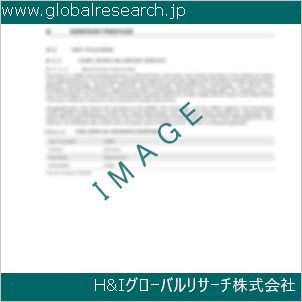Table of Contents
1 Industry Overview of Amylacetate
1.1 Definition and Specifications of Amylacetate
1.1.1 Definition of Amylacetate
1.1.2 Specifications of Amylacetate
1.2 Classification of Amylacetate
1.3 Applications of Amylacetate
1.3.1 Nuclear Application
1.3.2 Non-Nuclear Application
1.4 Industry Chain Structure of Amylacetate
1.5 Industry Overview and Major Regions Status of Amylacetate
1.5.1 Industry Overview of Amylacetate
1.5.2 Global Major Regions Status of Amylacetate
1.6 Industry Policy Analysis of Amylacetate
1.7 Industry News Analysis of Amylacetate
2 Manufacturing Cost Structure Analysis of Amylacetate
2.1 Raw Material Suppliers and Price Analysis of Amylacetate
2.2 Equipment Suppliers and Price Analysis of Amylacetate
2.3 Labor Cost Analysis of Amylacetate
2.4 Other Costs Analysis of Amylacetate
2.5 Manufacturing Cost Structure Analysis of Amylacetate
2.6 Manufacturing Process Analysis of Amylacetate
3 Technical Data and Manufacturing Plants Analysis of Amylacetate
3.1 Capacity and Commercial Production Date of Global Amylacetate Major Manufacturers in 2023
3.2 Manufacturing Plants Distribution of Global Amylacetate Major Manufacturers in 2023
3.3 R&D Status and Technology Source of Global Amylacetate Major Manufacturers in 2023
3.4 Raw Materials Sources Analysis of Global Amylacetate Major Manufacturers in 2023
4 Capacity, Production and Revenue Analysis of Amylacetate by Regions, Types and Manufacturers
4.1 Global Capacity, Production and Revenue of Amylacetate by Regions 2019-2024
4.2 Global and Major Regions Capacity, Production, Revenue and Growth Rate of Amylacetate 2019-2024
4.3 Global Capacity, Production and Revenue of Amylacetate by Types 2019-2024
4.4 Global Capacity, Production and Revenue of Amylacetate by Manufacturers 2019-2024
5 Price, Cost, Gross and Gross Margin Analysis of Amylacetate by Regions, Types and Manufacturers
5.1 Price, Cost, Gross and Gross Margin Analysis of Amylacetate by Regions 2019-2024
5.2 Price, Cost, Gross and Gross Margin Analysis of Amylacetate by Types 2019-2024
5.3 Price, Cost, Gross and Gross Margin Analysis of Amylacetate by Manufacturers 2019-2024
6 Consumption Volume, Consumption Value and Sale Price Analysis of Amylacetate by Regions, Types and Applications
6.1 Global Consumption Volume and Consumption Value of Amylacetate by Regions 2019-2024
6.2 Global and Major Regions Consumption Volume, Consumption Value and Growth Rate of Amylacetate 2019-2024
6.3 Global Consumption Volume and Consumption Value of Amylacetate by Types 2019-2024
6.4 Global Consumption Volume and Consumption Value of Amylacetate by Applications 2019-2024
6.5 Sale Price of Amylacetate by Regions 2019-2024
6.6 Sale Price of Amylacetate by Types 2019-2024
6.7 Sale Price of Amylacetate by Applications 2019-2024
6.8 Market Share Analysis of Amylacetate by Different Sale Price Levels
7 Supply, Import, Export and Consumption Analysis of Amylacetate
7.1 Supply, Consumption and Gap of Amylacetate 2019-2024
7.2 Global Capacity, Production, Price, Cost, Revenue, Supply, Import, Export and Consumption of Amylacetate 2019-2024
7.3 USA Capacity, Production, Price, Cost, Revenue, Supply, Import, Export and Consumption of Amylacetate 2019-2024
7.4 EU Capacity, Production, Price, Cost, Revenue, Supply, Import, Export and Consumption of Amylacetate 2019-2024
7.5 China Capacity, Production, Price, Cost, Revenue, Supply, Import, Export and Consumption of Amylacetate 2019-2024
7.6 Japan Capacity, Production, Price, Cost, Revenue, Supply, Import, Export and Consumption of Amylacetate 2019-2024
8 Major Manufacturers Analysis of Amylacetate
8.1 Manufacturer One
8.1.1 Company Profile
8.1.2 Product Picture and Specifications
8.1.2.1 Type I
8.1.2.2 Type II
8.1.2.3 Type III
8.1.3 Capacity, Production, Price, Cost, Gross and Revenue
8.1.4 Contact Information
8.2 Manufacturer Two
8.2.1 Company Profile
8.2.2 Product Picture and Specifications
8.2.2.1 Type I
8.2.2.2 Type II
8.2.2.3 Type III
8.2.3 Capacity, Production, Price, Cost, Gross and Revenue
8.2.4 Contact Information
8.3 Manufacturer Three
8.3.1 Company Profile
8.3.2 Product Picture and Specifications
8.3.2.1 Type I
8.3.2.2 Type II
8.3.2.3 Type III
8.3.3 Capacity, Production, Price, Cost, Gross and Revenue
8.3.4 Contact Information
8.4 Manufacturer Four
8.4.1 Company Profile
8.4.2 Product Picture and Specifications
8.4.2.1 Type I
8.4.2.2 Type II
8.4.2.3 Type III
8.4.3 Capacity, Production, Price, Cost, Gross and Revenue
8.4.4 Contact Information
8.5 Manufacturer Five
8.5.1 Company Profile
8.5.2 Product Picture and Specifications
8.5.2.1 Type I
8.5.2.2 Type II
8.5.2.3 Type III
8.5.3 Capacity, Production, Price, Cost, Gross and Revenue
8.5.4 Contact Information
…
9 Marketing Trader or Distributor Analysis of Amylacetate
9.1 Marketing Channels Status of Amylacetate
9.2 Traders or Distributors with Contact Information of Amylacetate by Regions
9.3 Ex-work Price, Channel Price and End Buyer Price Analysis of Amylacetate
9.4 Regional Import, Export and Trade Analysis of Amylacetate
10 Industry Chain Analysis of Amylacetate
10.1 Upstream Major Raw Materials Suppliers Analysis of Amylacetate
10.1.1 Major Raw Materials Suppliers with Contact Information Analysis of Amylacetate
10.1.2 Major Raw Materials Suppliers with Supply Volume Analysis of Amylacetate by Regions
10.2 Upstream Major Equipment Suppliers Analysis of Amylacetate
10.2.1 Major Equipment Suppliers with Contact Information Analysis of Amylacetate
10.2.2 Major Equipment Suppliers with Product Pictures Analysis of Amylacetate by Regions
10.3 Downstream Major Consumers Analysis of Amylacetate
10.3.1 Major Consumers with Contact Information Analysis of Amylacetate
10.3.2 Major Consumers with Consumption Volume Analysis of Amylacetate by Regions
10.4 Supply Chain Relationship Analysis of Amylacetate
11 Development Trend of Analysis of Amylacetate
11.1 Capacity, Production and Revenue Forecast of Amylacetate by Regions and Types
11.1.1 Global Capacity, Production and Revenue of Amylacetate by Regions 2024-2029
11.1.2 Global and Major Regions Capacity, Production, Revenue and Growth Rate of Amylacetate 2024-2029
11.1.3 Global Capacity, Production and Revenue of Amylacetate by Types 2024-2029
11.2 Consumption Volume and Consumption Value Forecast of Amylacetate by Regions, Types and Applications
11.2.1 Global Consumption Volume and Consumption Value of Amylacetate by Regions 2024-2029
11.2.2 Global and Major Regions Consumption Volume, Consumption Value and Growth Rate of Amylacetate 2024-2029
11.2.3 Global Consumption Volume and Consumption Value of Amylacetate by Types 2024-2029
11.2.4 Global Consumption Volume and Consumption Value of Amylacetate by Applications 2024-2029
11.3 Supply, Import, Export and Consumption Forecast of Amylacetate
11.3.1 Supply, Consumption and Gap of Amylacetate 2024-2029
11.3.2 Global Capacity, Production, Price, Cost, Revenue, Supply, Import, Export and Consumption of Amylacetate 2024-2029
11.3.3 USA Capacity, Production, Price, Cost, Revenue, Supply, Import, Export and Consumption of Amylacetate 2024-2029
11.3.4 EU Capacity, Production, Price, Cost, Revenue, Supply, Import, Export and Consumption of Amylacetate 2024-2029
11.3.5 China Capacity, Production, Price, Cost, Revenue, Supply, Import, Export and Consumption of Amylacetate 2024-2029
11.3.6 Japan Capacity, Production, Price, Cost, Revenue, Supply, Import, Export and Consumption of Amylacetate 2024-2029
12 New Project Investment Feasibility Analysis of Amylacetate
12.1 New Project SWOT Analysis of Amylacetate
12.2 New Project Investment Feasibility Analysis of Amylacetate
13 Conclusion of the Global Amylacetate (CAS 628-63-7) Industry 2024 Market Research Report
| ※参考情報 酢酸アミル(Amylacetate)は、化学式C5H10O2を持つ有機化合物で、CAS番号は628-63-7です。酢酸アミルは、芳香のある液体であり、主に溶剤や香料として広く使用されています。その特性や用途に関して、以下に説明いたします。 酢酸アミルは、酢酸とアミルアルコールのエステルであり、無色透明の液体です。その香りは果物のような甘い香りが特徴で、特にバナナやアーモンドを思わせる香りとして知られています。このため、食品や香水、化粧品などの製品において香料としての利用が盛んです。また、酢酸アミルは揮発性が高く、使用後には速やかに蒸発するため、残留感が少なく、清涼感を与えるのにも適しているとされています。 酢酸アミルは、化学的にはエステルに分類されるため、他のエステルと同様に、様々な化学反応を通じて生成されます。主な製造方法としては、アミルアルコールと酢酸を酸触媒のもとで反応させる手法が一般的です。この反応は、エステル化反応と呼ばれ、脱水反応を伴うことから、触媒の存在が重要です。また、反応条件(温度や圧力など)を調整することで、収率や純度を向上させることが可能です。 酢酸アミルの用途は多岐にわたります。まず、香料としての利用は非常に重要で、食品業界においては、菓子、飲料、アイスクリームなどに添加され、特に果物の香りを持たせるために使用されます。さらに、香水や化粧品でも、製品に独特の香りを与えるための成分としてしばしば利用されています。これにより、消費者に対して魅力的な製品を提供することが可能になります。 また、酢酸アミルは溶剤としても広く使用される存在です。例えば、塗料、接着剤、インクなどの製造において、溶剤としての役割を果たします。特に、酢酸アミルは揮発性が高いため、塗料やインクが乾燥しやすく、作業が効率的に進むという利点があります。さらに、樹脂やプラスチックの加工においても、酢酸アミルは重要な役割を担っています。 酢酸アミルの利用における関連技術も注目されています。たとえば、酢酸アミルを含む香料の生成において、合成生物学や化学合成の技術向上により、より効率的で安全な製造プロセスを開発する研究が進められています。また、酢酸アミルの新しい用途の探求や、環境に配慮した持続可能な製造方法の開発も重要な研究課題となっています。 それに伴い、酢酸アミルの安全性や環境への影響についての研究も進んでいます。酢酸アミルは、商業的に利用される際には適切な取り扱いが求められます。特に、揮発性であるため、吸入などのリスクが考慮されるべきです。また、皮膚との接触や目への刺激にも注意が必要です。これらのリスクを軽減するためには、適切な個人保護具を使用し、作業環境を整えることが重要です。 環境への影響についても、酢酸アミルの分解性や生物蓄積性が研究の対象となっています。一般的に、酢酸アミルは自然環境において比較的速やかに分解されることが知られており、環境への影響は限定的と考えられています。しかし、使用量が増加するにつれて、今後もその影響について慎重に評価していく必要があります。 このように、酢酸アミルはその甘い香りと溶剤としての特性から、様々な産業において重要な役割を果たしており、今後もその利用拡大が期待されています。香料や溶剤としての用途に加え、環境に配慮した持続可能な製造方法の開発や新しい用途の探求が進む中で、酢酸アミルがどのような新しい可能性を秘めているのか、ますます注目が高まることでしょう。企業や研究機関は、この化合物の特性を深化させ、より良い製品を生み出すために努力を続けています。 |
❖ 免責事項 ❖
http://www.globalresearch.jp/disclaimer












